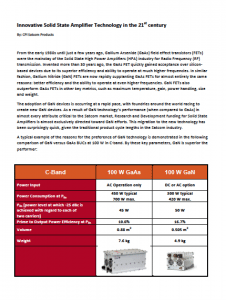Latest News
 From the early 1980s until just a few years ago, Gallium Arsenide (GaAs) field effect transistors (FETs) were the mainstay of the Solid State High Power Amplifiers (HPA) industry for Radio Frequency (RF) transmission. Invented more than 30 years ago, the GaAs FET quickly gained acceptance over silicon-based devices due to its superior efficiency and ability to operate at much higher frequencies. In similar fashion, Gallium Nitride (GaN) FETs are now rapidly supplanting GaAs FETs for almost entirely the same reasons: better efficiency and the ability to operate at even higher frequencies. GaN FETs also outperform GaAs FETs in other key metrics, such as maximum temperature, gain, power handling, size and weight.
From the early 1980s until just a few years ago, Gallium Arsenide (GaAs) field effect transistors (FETs) were the mainstay of the Solid State High Power Amplifiers (HPA) industry for Radio Frequency (RF) transmission. Invented more than 30 years ago, the GaAs FET quickly gained acceptance over silicon-based devices due to its superior efficiency and ability to operate at much higher frequencies. In similar fashion, Gallium Nitride (GaN) FETs are now rapidly supplanting GaAs FETs for almost entirely the same reasons: better efficiency and the ability to operate at even higher frequencies. GaN FETs also outperform GaAs FETs in other key metrics, such as maximum temperature, gain, power handling, size and weight.
The adoption of GaN devices is occurring at a rapid pace, with foundries around the world racing to create new GaN devices. As a result of GaN technology’s performance (when compared to GaAs) in almost every attribute critical to the Satcom market, Research and Development funding for Solid State Amplifiers is almost exclusively directed toward GaN efforts. This migration to the new technology has been surprisingly quick, given the traditional product cycle lengths in the Satcom industry.
A typical example of the reasons for the preference of GaN technology is demonstrated in the following comparison of GaN versus GaAs BUCs at…
To learn more, download CPI’s latest whitepaper now!
By submitting this form, you give CPI and Access Intelligence consent to email you about relevant products, services, announcements and offers.
Get the latest Via Satellite news!
Subscribe Now